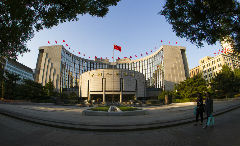Central bank confident of averting rate hike fallout
2018-06-13
China Daily
The People’s Bank of China, the central bank, is now more confident about using flexible monetary policy tools to cope with an impending US funds rate hike later this week, without disturbing the predetermined financial deleveraging pace and interest rate reform, said economists.
Monetary tightening measures are likely to continue in China to curb credit risk, given the recent moderate growth of money supply and bank lending. The monetary policymakers, however, should no longer be nagged by debating whether to follow the US steps, as domestic economic conditions and the still-high debt ratio will continue to be the top concern, they said.
The financial data for May, released on June 12 by the PBOC, showed that the broad money supply, or M2, witnessed a year-on-year growth rate of 8.3 percent, lower than the expected 8.5 to 8.8 percent.
Total social financing, a broad measure of credit and liquidity in the economy including off-balance sheet forms of financing, dropped sharply to 760.8 billion yuan ($118.80 billion) last month from 1.56 trillion yuan in April. Yuan-denominated bank lending increased by 1.15 trillion yuan, compared with 1.18 trillion yuan in April, the PBOC said.
All the data pointed to a relatively tightening monetary environment, which can accelerate financial deleveraging and curb asset bubbles especially in the property sector, said Yang Weiyong, a professor at the University of International Business and Economics in Beijing.
The country’s general interest rate level still has much room for improvement, especially in market-oriented pricing so as to enable the flow of more financial resources into more efficient production to sustain economic restructuring reforms, according to Yang.
Expectations are rife that the US Federal Reserve will take the next move on monetary tightening after its regular Open Market Committee meeting on June 13. The seventh rise of its funds rate since 2015 would lift the target range to 1.75 to 2 percent.
“China may increase the interest rates for open market operations following the possible US rate hike, but in a moderate way, a similar move as it took in December and March,” said Yang, who also suggested a further cut in the cash that banks set aside as reserves when liquidity risk increases.
In the past two years, the PBOC has mainly relied on open market operations and innovative lending facilities, including the standing lending facility and the medium-term lending facility, to manage market liquidity.
Zhu Haibin, chief China economist and head of China Equity Strategy, JPMorgan, said that the PBOC can use various and flexible liquidity instruments to guide financial market interest rates.
Trends are indicative that the central bank is willing to further improve interest rate reform, with a target to achieve market-oriented floating interest rates with risk-based pricing, but the authority wishes to keep the process smooth without sparking any chaos in the market, according to Zhu.


